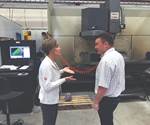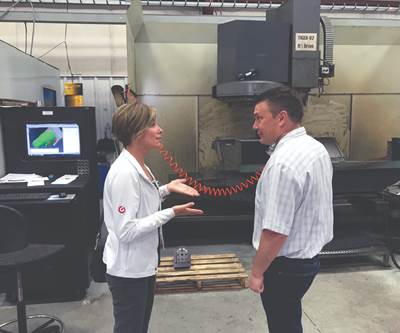Leadtime Leader Q&A: X-Cell Tool and Mold on Automation
X-Cell Tool and Mold discusses how automation is used to increase machine utilization and reduce costs.
Automating machining processes has been a critical component to X-Cell Tool’s ability to reduce lead times. When did you first begin using it and why?
Jim Cummings, general manager: It was back in 2011 that we started looking at robots for our EDM cells in an effort to reduce cost by increasing unattended time. The next benefit was the longer continuous run times; we were also increasing machine utilization as well.
How are you currently using automation in your shop?
Cummings: The current thought process is similar, but the motivation is now leaning more toward machine utilization as opposed to unattended time. I think the mindset has shifted more toward the idea that, if the machine is going to run, it will run unattended (that is a given), so let’s run it continuously for as long as possible. Then let’s have the next job ready to set up and minimize the downtime. We want to productionize the machining process, running jobs in batches, order-by-order, rather than running like a job shop where it is workpiece by workpiece. Our machines that have integrated robots are production centers, and we need to get as many hours out of them as possible. Of course, you always have those ones, twos and “fews” that can be disruptive, but they need to be done as well. The best time to get those completed is during the day when your moldmaker is there to set them up. But at the end of the day, the moldmaker must be ready to turn that robot back on and run production through the night.
So we have established another mantra at X-Cell. When you punch that time clock in the morning, you should already be asking yourself, “What am I going have ready to run tonight?” At that point, you spend the time to set up that next long-running job. Maybe it takes until lunchtime to have it ready, and that’s okay because now you have the rest of the day to get those two parts for that other job done, too. At the end of the day, you can turn your robot on and start running the production job you set up earlier in the day.
Another possible scenario is you have a production job set up using your robot, and it is running when you arrive in the morning. That is great! In that case, when the robot comes to a good stopping point, you can pause the program, put the production pallets back in the carousel, bring an empty magnet, vise or pallet into the machine and set up those two parts to get them done during the day. When those two parts are done, flip that robot back on, and you are running in auto through the night. It is all about the UP TIME.
Bottom line, you need to have the mindset of “What am I running tonight?” and plan for that to happen.
Does X-Cell Tool have a plan for expanding its automation capabilities in the short-term? If yes, please share that plan and the motivation for it. If not, what is your next operational focus?
Cummings: Currently, we are creating a five-Axis Yasda Hard Mill Work Cell that will include our current YMC 430, a new YMC 650 and upgrading an existing System 3R WorkPartner robot. By upgrading the robot capacity with another bookshelf configured for taller components and positioning the robot between these two five-axis machines, it will serve both machines.
This type of cell requires more attention to dialing it in because cutter wear can affect quality when holding the 0.0001-inch tolerance. Therefore, our goal is to set up a hard mill operation to rough at night and finish during the day when we have the operator there to monitor the quality.
We are also looking into adding automation to our lathes for soft turning. Again, this is with the primary goal of increasing our utilization of those machines.
Related Content
Laser Welding Versus Micro Welding
The latest battle in finely detailed restoration/repair of mold materials.
Read MoreMaintaining a Wire EDM Machine
To achieve the ultimate capability and level of productivity from your wire EDM on a consistent, repeatable and reliable basis, regular maintenance is a required task.
Read MoreThe Ins and Outs of Hot Runner Temperature Control
A training checklist that explains the why and how of proper hot runner temperature control and system management.
Read MoreRead Next
Leadtime Leader Q&A with Maximum Mold Group
MoldMaking Technology invited the owner of this year’s Leadtime Leader winning shop to share his thoughts on the impact of winning the award.
Read MoreAre You a Moldmaker Considering 3D Printing? Consider the 3D Printing Workshop at NPE2024
Presentations will cover 3D printing for mold tooling, material innovation, product development, bridge production and full-scale, high-volume additive manufacturing.
Read MoreReasons to Use Fiber Lasers for Mold Cleaning
Fiber lasers offer a simplicity, speed, control and portability, minimizing mold cleaning risks.
Read More




















